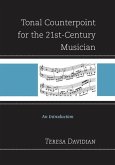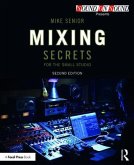- Broschiertes Buch
- Merkliste
- Auf die Merkliste
- Bewerten Bewerten
- Teilen
- Produkt teilen
- Produkterinnerung
- Produkterinnerung
Rhythms, melodies, and harmonies are the building blocks of music. In Music Theory Secrets: 94 Strategies for the Starting Musician, Brent Coppenbarger offers a full range of methods to help musicians, not only grasp, but remember those key elements upon which the music they play is built: pitch, rhythm, scales, key signatures, and harmony.
Andere Kunden interessierten sich auch für
![Cello Secrets Cello Secrets]() Brian HodgesCello Secrets57,99 €
Brian HodgesCello Secrets57,99 €![Harmonic Secrets of Arabic Music Scales Harmonic Secrets of Arabic Music Scales]() Cameron PowersHarmonic Secrets of Arabic Music Scales23,99 €
Cameron PowersHarmonic Secrets of Arabic Music Scales23,99 €![Songwriting Secrets Songwriting Secrets]() Aulsondro "Emcee N. I. C. E. HamiltonSongwriting Secrets29,99 €
Aulsondro "Emcee N. I. C. E. HamiltonSongwriting Secrets29,99 €![Creating Music Creating Music]() Patricia Elaine RileyCreating Music99,99 €
Patricia Elaine RileyCreating Music99,99 €![Music Theory for the Self-Taught Musician Music Theory for the Self-Taught Musician]() Will MetzMusic Theory for the Self-Taught Musician28,99 €
Will MetzMusic Theory for the Self-Taught Musician28,99 €![Tonal Counterpoint for the 21st-Century Musician Tonal Counterpoint for the 21st-Century Musician]() Teresa DavidianTonal Counterpoint for the 21st-Century Musician134,99 €
Teresa DavidianTonal Counterpoint for the 21st-Century Musician134,99 €![Mixing Secrets for the Small Studio Mixing Secrets for the Small Studio]() Mike SeniorMixing Secrets for the Small Studio44,99 €
Mike SeniorMixing Secrets for the Small Studio44,99 €-
-
-
Rhythms, melodies, and harmonies are the building blocks of music. In Music Theory Secrets: 94 Strategies for the Starting Musician, Brent Coppenbarger offers a full range of methods to help musicians, not only grasp, but remember those key elements upon which the music they play is built: pitch, rhythm, scales, key signatures, and harmony.
Hinweis: Dieser Artikel kann nur an eine deutsche Lieferadresse ausgeliefert werden.
Hinweis: Dieser Artikel kann nur an eine deutsche Lieferadresse ausgeliefert werden.
Produktdetails
- Produktdetails
- Verlag: Rowman & Littlefield Publishers
- Seitenzahl: 156
- Erscheinungstermin: 20. August 2014
- Englisch
- Abmessung: 254mm x 178mm x 9mm
- Gewicht: 308g
- ISBN-13: 9781442233232
- ISBN-10: 1442233230
- Artikelnr.: 40789105
- Herstellerkennzeichnung
- Libri GmbH
- Europaallee 1
- 36244 Bad Hersfeld
- gpsr@libri.de
- Verlag: Rowman & Littlefield Publishers
- Seitenzahl: 156
- Erscheinungstermin: 20. August 2014
- Englisch
- Abmessung: 254mm x 178mm x 9mm
- Gewicht: 308g
- ISBN-13: 9781442233232
- ISBN-10: 1442233230
- Artikelnr.: 40789105
- Herstellerkennzeichnung
- Libri GmbH
- Europaallee 1
- 36244 Bad Hersfeld
- gpsr@libri.de
Brent Coppenbarger is professor of music at the Cline School of Music at North Greenville University in Tigerville, South Carolina where he has taught music theory and woodwinds since 1995. He has published in The Clarinet, NACWPI Journal, and The Instrumentalist. He is also a composer who works are available from Dorn Publications and Musica Rara.
Quick Reference Guide to Helpful Tables Preface Acknowledgments Prelude
Chapter 1: Pitch and Rhythm Basics Secret 1: Pitch Basics Secret 2: The
Treble Clef or G Clef Secret 3: The Bass Clef or F Clef Secret 4: The Alto
Clef & The Tenor Clef Secret 5: The Grand Staff Secret 6: Rhythm Secret 7:
Time Signature Secret 8: Meter Secret 9: Simple Meter Secret 10: Compound
Meter Secret 11: Asymmetrical Meter Secret 12: Counting in Simple Meter
Secret 13: Counting in Compound Meter Secret 14: Practice Makes Perfect
Chapter 2: Major Scales and Major Key Signatures Secret 15: The Scale
Secret 16: The Major Scale Secret 17: The Major Tetrachord Secret 18: Key
Signatures Secret 19: The Order of Flats Secret 20: The Order of Sharps
Secret 21: The Sharp Key Signatures in Major Secret 22: The Flat Key
Signatures in Major Chapter 3: Minor Scales and Minor Key Signatures Secret
23: Minor Scales Secret 24: Parallel Minor Secret 25: Relative Minor Secret
26: Natural Minor Form Secret 27: Harmonic Minor Form Secret 28: Melodic
Minor Form Chapter 4: Other Scales Secret 29: The Chromatic Scale Secret
30: The Whole Tone Scale Secret 31: The Pentatonic Scale Secret 32: Dorian
Mode Secret 33: Phrygian Mode Secret 34: Lydian Mode Secret 35: Mixolydian
Mode Secret 36: The Seven Note Blues Scale Secret 37: The Bebop Scale
Secret 38: Less Common Scales Chapter 5: Scale Degree Names and Intervals
Secret 39: Scale Degree Names Secret 40: The Interval Secret 41: Major
Intervals Secret 42: Perfect Intervals Secret 43: Minor Intervals Secret
44: Augmented Intervals Secret 45: Diminished Intervals Secret 46: The
Tritone Chapter 6: Triads Secret 47: Major Triads Secret 48: Minor Triads
Secret 49: Augmented Triads Secret 50: Diminished Triads Chapter 7: Chords
Secret 51: The Major Seventh Chord Secret 52: The Major-Minor Seventh Chord
Secret 53: The Minor Seventh Chord Secret 54: The Diminished Seventh Chord
Secret 55: The Half-Diminished & Fully-Diminished Seventh Chord Secret 56:
Other Chords Chapter 8: Roman Numeral Analysis Secret 57: Roman Numeral
Quality Secret 58: Roman Numerals in Major Keys Secret 59: Roman Numerals
in Minor Keys Secret 60: Four-Part Roman Numeral Analysis Chapter 9:
Inversions of the Chord and Figured Bass Secret 61: The Root Position Triad
Secret 62: The First Inversion Triad Secret 63: The Second Inversion Triad
Secret 64: Figured Bass Secret 65: Root Position Figured Bass Secret 66:
First Inversion Figured Bass Secret 67: Second Inversion Figured Bass
Secret 68: Seventh Chord Figured Bass Secret 69: Lead Sheet Inversions
Chapter 10: Non-Chord Tones Secret 70: Non-Chord Tones Defined Secret 71:
The Passing Tone Secret 72: The Neighbor Tone Secret 73: The Escape Tone
Secret 74: The Appoggiatura Secret 75: The Anticipation Secret 76: The
Suspension Secret 77: The Pedal Tone Secret 78: Using Non-Chord Tones To
Improvise Chapter 11: Singing with Solfège Syllables Secret 79: Sight
Singing Secret 80: Solfège Syllables in Major Secret 81: Solfège Syllables
in Natural Minor Secret 82: Solfège Syllables in Harmonic Minor Secret 83:
Solfège Syllables in Melodic Minor Secret 84: Other Methods of Sight
Singing Chapter 12: Transposition Secret 85: Concert Pitch Instruments
Secret 86: Transposing Instruments Secret 87: Transposing Parts Secret 88:
Transposing Using Solfege Syllables Secret 89: Transposing Keys Secret 90:
The Transposition Table Chapter 13: Advanced Concepts Secret 91: Four Part
Analysis Secret 92: Part-writing Rules Secret 93: The Sequence Secret 94:
Form Appendix 1: Chorale Analysis Appendix 2: Suggested Further Reading
About the Author Index
Chapter 1: Pitch and Rhythm Basics Secret 1: Pitch Basics Secret 2: The
Treble Clef or G Clef Secret 3: The Bass Clef or F Clef Secret 4: The Alto
Clef & The Tenor Clef Secret 5: The Grand Staff Secret 6: Rhythm Secret 7:
Time Signature Secret 8: Meter Secret 9: Simple Meter Secret 10: Compound
Meter Secret 11: Asymmetrical Meter Secret 12: Counting in Simple Meter
Secret 13: Counting in Compound Meter Secret 14: Practice Makes Perfect
Chapter 2: Major Scales and Major Key Signatures Secret 15: The Scale
Secret 16: The Major Scale Secret 17: The Major Tetrachord Secret 18: Key
Signatures Secret 19: The Order of Flats Secret 20: The Order of Sharps
Secret 21: The Sharp Key Signatures in Major Secret 22: The Flat Key
Signatures in Major Chapter 3: Minor Scales and Minor Key Signatures Secret
23: Minor Scales Secret 24: Parallel Minor Secret 25: Relative Minor Secret
26: Natural Minor Form Secret 27: Harmonic Minor Form Secret 28: Melodic
Minor Form Chapter 4: Other Scales Secret 29: The Chromatic Scale Secret
30: The Whole Tone Scale Secret 31: The Pentatonic Scale Secret 32: Dorian
Mode Secret 33: Phrygian Mode Secret 34: Lydian Mode Secret 35: Mixolydian
Mode Secret 36: The Seven Note Blues Scale Secret 37: The Bebop Scale
Secret 38: Less Common Scales Chapter 5: Scale Degree Names and Intervals
Secret 39: Scale Degree Names Secret 40: The Interval Secret 41: Major
Intervals Secret 42: Perfect Intervals Secret 43: Minor Intervals Secret
44: Augmented Intervals Secret 45: Diminished Intervals Secret 46: The
Tritone Chapter 6: Triads Secret 47: Major Triads Secret 48: Minor Triads
Secret 49: Augmented Triads Secret 50: Diminished Triads Chapter 7: Chords
Secret 51: The Major Seventh Chord Secret 52: The Major-Minor Seventh Chord
Secret 53: The Minor Seventh Chord Secret 54: The Diminished Seventh Chord
Secret 55: The Half-Diminished & Fully-Diminished Seventh Chord Secret 56:
Other Chords Chapter 8: Roman Numeral Analysis Secret 57: Roman Numeral
Quality Secret 58: Roman Numerals in Major Keys Secret 59: Roman Numerals
in Minor Keys Secret 60: Four-Part Roman Numeral Analysis Chapter 9:
Inversions of the Chord and Figured Bass Secret 61: The Root Position Triad
Secret 62: The First Inversion Triad Secret 63: The Second Inversion Triad
Secret 64: Figured Bass Secret 65: Root Position Figured Bass Secret 66:
First Inversion Figured Bass Secret 67: Second Inversion Figured Bass
Secret 68: Seventh Chord Figured Bass Secret 69: Lead Sheet Inversions
Chapter 10: Non-Chord Tones Secret 70: Non-Chord Tones Defined Secret 71:
The Passing Tone Secret 72: The Neighbor Tone Secret 73: The Escape Tone
Secret 74: The Appoggiatura Secret 75: The Anticipation Secret 76: The
Suspension Secret 77: The Pedal Tone Secret 78: Using Non-Chord Tones To
Improvise Chapter 11: Singing with Solfège Syllables Secret 79: Sight
Singing Secret 80: Solfège Syllables in Major Secret 81: Solfège Syllables
in Natural Minor Secret 82: Solfège Syllables in Harmonic Minor Secret 83:
Solfège Syllables in Melodic Minor Secret 84: Other Methods of Sight
Singing Chapter 12: Transposition Secret 85: Concert Pitch Instruments
Secret 86: Transposing Instruments Secret 87: Transposing Parts Secret 88:
Transposing Using Solfege Syllables Secret 89: Transposing Keys Secret 90:
The Transposition Table Chapter 13: Advanced Concepts Secret 91: Four Part
Analysis Secret 92: Part-writing Rules Secret 93: The Sequence Secret 94:
Form Appendix 1: Chorale Analysis Appendix 2: Suggested Further Reading
About the Author Index
Quick Reference Guide to Helpful Tables Preface Acknowledgments Prelude
Chapter 1: Pitch and Rhythm Basics Secret 1: Pitch Basics Secret 2: The
Treble Clef or G Clef Secret 3: The Bass Clef or F Clef Secret 4: The Alto
Clef & The Tenor Clef Secret 5: The Grand Staff Secret 6: Rhythm Secret 7:
Time Signature Secret 8: Meter Secret 9: Simple Meter Secret 10: Compound
Meter Secret 11: Asymmetrical Meter Secret 12: Counting in Simple Meter
Secret 13: Counting in Compound Meter Secret 14: Practice Makes Perfect
Chapter 2: Major Scales and Major Key Signatures Secret 15: The Scale
Secret 16: The Major Scale Secret 17: The Major Tetrachord Secret 18: Key
Signatures Secret 19: The Order of Flats Secret 20: The Order of Sharps
Secret 21: The Sharp Key Signatures in Major Secret 22: The Flat Key
Signatures in Major Chapter 3: Minor Scales and Minor Key Signatures Secret
23: Minor Scales Secret 24: Parallel Minor Secret 25: Relative Minor Secret
26: Natural Minor Form Secret 27: Harmonic Minor Form Secret 28: Melodic
Minor Form Chapter 4: Other Scales Secret 29: The Chromatic Scale Secret
30: The Whole Tone Scale Secret 31: The Pentatonic Scale Secret 32: Dorian
Mode Secret 33: Phrygian Mode Secret 34: Lydian Mode Secret 35: Mixolydian
Mode Secret 36: The Seven Note Blues Scale Secret 37: The Bebop Scale
Secret 38: Less Common Scales Chapter 5: Scale Degree Names and Intervals
Secret 39: Scale Degree Names Secret 40: The Interval Secret 41: Major
Intervals Secret 42: Perfect Intervals Secret 43: Minor Intervals Secret
44: Augmented Intervals Secret 45: Diminished Intervals Secret 46: The
Tritone Chapter 6: Triads Secret 47: Major Triads Secret 48: Minor Triads
Secret 49: Augmented Triads Secret 50: Diminished Triads Chapter 7: Chords
Secret 51: The Major Seventh Chord Secret 52: The Major-Minor Seventh Chord
Secret 53: The Minor Seventh Chord Secret 54: The Diminished Seventh Chord
Secret 55: The Half-Diminished & Fully-Diminished Seventh Chord Secret 56:
Other Chords Chapter 8: Roman Numeral Analysis Secret 57: Roman Numeral
Quality Secret 58: Roman Numerals in Major Keys Secret 59: Roman Numerals
in Minor Keys Secret 60: Four-Part Roman Numeral Analysis Chapter 9:
Inversions of the Chord and Figured Bass Secret 61: The Root Position Triad
Secret 62: The First Inversion Triad Secret 63: The Second Inversion Triad
Secret 64: Figured Bass Secret 65: Root Position Figured Bass Secret 66:
First Inversion Figured Bass Secret 67: Second Inversion Figured Bass
Secret 68: Seventh Chord Figured Bass Secret 69: Lead Sheet Inversions
Chapter 10: Non-Chord Tones Secret 70: Non-Chord Tones Defined Secret 71:
The Passing Tone Secret 72: The Neighbor Tone Secret 73: The Escape Tone
Secret 74: The Appoggiatura Secret 75: The Anticipation Secret 76: The
Suspension Secret 77: The Pedal Tone Secret 78: Using Non-Chord Tones To
Improvise Chapter 11: Singing with Solfège Syllables Secret 79: Sight
Singing Secret 80: Solfège Syllables in Major Secret 81: Solfège Syllables
in Natural Minor Secret 82: Solfège Syllables in Harmonic Minor Secret 83:
Solfège Syllables in Melodic Minor Secret 84: Other Methods of Sight
Singing Chapter 12: Transposition Secret 85: Concert Pitch Instruments
Secret 86: Transposing Instruments Secret 87: Transposing Parts Secret 88:
Transposing Using Solfege Syllables Secret 89: Transposing Keys Secret 90:
The Transposition Table Chapter 13: Advanced Concepts Secret 91: Four Part
Analysis Secret 92: Part-writing Rules Secret 93: The Sequence Secret 94:
Form Appendix 1: Chorale Analysis Appendix 2: Suggested Further Reading
About the Author Index
Chapter 1: Pitch and Rhythm Basics Secret 1: Pitch Basics Secret 2: The
Treble Clef or G Clef Secret 3: The Bass Clef or F Clef Secret 4: The Alto
Clef & The Tenor Clef Secret 5: The Grand Staff Secret 6: Rhythm Secret 7:
Time Signature Secret 8: Meter Secret 9: Simple Meter Secret 10: Compound
Meter Secret 11: Asymmetrical Meter Secret 12: Counting in Simple Meter
Secret 13: Counting in Compound Meter Secret 14: Practice Makes Perfect
Chapter 2: Major Scales and Major Key Signatures Secret 15: The Scale
Secret 16: The Major Scale Secret 17: The Major Tetrachord Secret 18: Key
Signatures Secret 19: The Order of Flats Secret 20: The Order of Sharps
Secret 21: The Sharp Key Signatures in Major Secret 22: The Flat Key
Signatures in Major Chapter 3: Minor Scales and Minor Key Signatures Secret
23: Minor Scales Secret 24: Parallel Minor Secret 25: Relative Minor Secret
26: Natural Minor Form Secret 27: Harmonic Minor Form Secret 28: Melodic
Minor Form Chapter 4: Other Scales Secret 29: The Chromatic Scale Secret
30: The Whole Tone Scale Secret 31: The Pentatonic Scale Secret 32: Dorian
Mode Secret 33: Phrygian Mode Secret 34: Lydian Mode Secret 35: Mixolydian
Mode Secret 36: The Seven Note Blues Scale Secret 37: The Bebop Scale
Secret 38: Less Common Scales Chapter 5: Scale Degree Names and Intervals
Secret 39: Scale Degree Names Secret 40: The Interval Secret 41: Major
Intervals Secret 42: Perfect Intervals Secret 43: Minor Intervals Secret
44: Augmented Intervals Secret 45: Diminished Intervals Secret 46: The
Tritone Chapter 6: Triads Secret 47: Major Triads Secret 48: Minor Triads
Secret 49: Augmented Triads Secret 50: Diminished Triads Chapter 7: Chords
Secret 51: The Major Seventh Chord Secret 52: The Major-Minor Seventh Chord
Secret 53: The Minor Seventh Chord Secret 54: The Diminished Seventh Chord
Secret 55: The Half-Diminished & Fully-Diminished Seventh Chord Secret 56:
Other Chords Chapter 8: Roman Numeral Analysis Secret 57: Roman Numeral
Quality Secret 58: Roman Numerals in Major Keys Secret 59: Roman Numerals
in Minor Keys Secret 60: Four-Part Roman Numeral Analysis Chapter 9:
Inversions of the Chord and Figured Bass Secret 61: The Root Position Triad
Secret 62: The First Inversion Triad Secret 63: The Second Inversion Triad
Secret 64: Figured Bass Secret 65: Root Position Figured Bass Secret 66:
First Inversion Figured Bass Secret 67: Second Inversion Figured Bass
Secret 68: Seventh Chord Figured Bass Secret 69: Lead Sheet Inversions
Chapter 10: Non-Chord Tones Secret 70: Non-Chord Tones Defined Secret 71:
The Passing Tone Secret 72: The Neighbor Tone Secret 73: The Escape Tone
Secret 74: The Appoggiatura Secret 75: The Anticipation Secret 76: The
Suspension Secret 77: The Pedal Tone Secret 78: Using Non-Chord Tones To
Improvise Chapter 11: Singing with Solfège Syllables Secret 79: Sight
Singing Secret 80: Solfège Syllables in Major Secret 81: Solfège Syllables
in Natural Minor Secret 82: Solfège Syllables in Harmonic Minor Secret 83:
Solfège Syllables in Melodic Minor Secret 84: Other Methods of Sight
Singing Chapter 12: Transposition Secret 85: Concert Pitch Instruments
Secret 86: Transposing Instruments Secret 87: Transposing Parts Secret 88:
Transposing Using Solfege Syllables Secret 89: Transposing Keys Secret 90:
The Transposition Table Chapter 13: Advanced Concepts Secret 91: Four Part
Analysis Secret 92: Part-writing Rules Secret 93: The Sequence Secret 94:
Form Appendix 1: Chorale Analysis Appendix 2: Suggested Further Reading
About the Author Index








